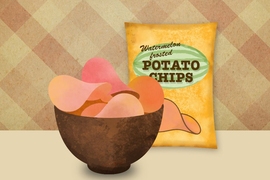Diet Crystal Pepsi. Frito Lay Lemonade. Watermelon-flavored Oreos. Through the years, the shelves of stores have been filled with products that turned out to be flops, failures, duds, and losers.
But only briefly filled with them, of course, because products like these tend to get yanked from stores quickly, leaving most consumers to wonder: Who exactly buys these things, anyway?
Now a published study co-authored by two MIT professors answers that question. Amazingly, the same group of consumers has an outsized tendency to purchase all kinds of failed products, time after time, flop after flop, Diet Crystal Pepsi after Diet Crystal Pepsi. The study calls the people in this group “harbingers of failure” and suggests they provide a new window into consumer behavior.
“These harbingers of failure have the unusual property that they keep on buying products that are taken from the shelves,” says MIT marketing professor Catherine Tucker, co-author of a paper detailing the study’s results.
Significantly, Tucker adds, these star-crossed consumers can sniff out flop-worthy products of all kinds.
“This is a cross-category effect,” Tucker explains. “If you’re the kind of person who bought something that really didn’t resonate with the market, say, coffee-flavored Coca-Cola, then that also means you’re more likely to buy a type of toothpaste or laundry detergent that fails to resonate with the market.”
And while strong initial sales of products normally seem like a good thing, the research reveals that is not always the case — not if it’s the harbingers of failure who are rushing out to purchase those products.
“It’s not just how many people are buying them, it’s how many of the right people are buying them and how many of the wrong people aren’t buying them,” says Duncan Simester, an MIT marketing professor and another co-author of the study.
“Usually when you’re doing market research, the common wisdom is that people liking your product is a good thing,” Tucker adds. “But what we’ve done in this research is identify a group of people who you really want to [have] hate your product. And that changes the paradigm of market research.”
What were they thinking?
The paper detailing the study’s results is published in the Journal of Marketing Research. The co-authors are Simester, who is the Nanyang Technological University Professor of Marketing at the MIT Sloan School of Management; Tucker, the Sloan Distinguished Professor of Management at MIT Sloan; Eric Anderson, a professor of marketing at Northwestern University’s Kellogg School of Management; and Song Lin, an assistant professor at Hong Kong University of Science and Technology’s business school.
The study itself draws upon two large data sets from a large chain of convenience stores that reaches across the U.S. One data set consists of weekly aggregate transactions from 111 store branches, from January 2003 to October 2009. The other data set consists of individual-level transaction data from November 2003 to November 2005.
All told, the researchers ended up examining 77,744 customers who purchased 8,809 new products between 2003 and 2005, and then tracking the aggregate data longer to see how well those products fared. They defined a failed product as one pulled from stores less than three years after its introduction; only about 40 percent of the new products survived that long.
In a key part of the study, the researchers studied consumers whose purchases flop at least 50 percent of the time, and saw pronounced effects when these harbingers of failure buy products. When the percentage of total sales of a product accounted for by these consumers increases from 25 to 50 percent, the probability of success for that product decreases by 31 percent. And when the harbingers buy a product at least three times, it’s really bad news: The probability of success for that product drops 56 percent.
But what explains the consumer behavior of the harbingers of failure?
“You could think of it as preference for risk,” Simester says. “People who are more willing to take a risk on an unusual product are more willing to take a risk in multiple categories.”
The researchers also examined and ruled out other possible explanations of the phenomenon. For instance: The harbingers are not evidently any more tired or distracted than anyone else when choosing products.
“It’s not the case that these people are buying goods at 2 in the morning, or something like that,” Tucker says. “They’re not inattentive. Systematically, they are able to identify these really terrible products that fail to resonate with the mainstream.”
A result that “may end up changing management practice”
Other scholars in the field say the study has fresh insights and is methodologically solid. Christophe Van den Bulte, a professor at The Wharton School of the University of Pennsylvania, who was involved in the review process for the paper, says it “documents a new phenomenon” and as such “may end up changing actual management practice.” He also notes that the finding is “robust to several variations in how the data are analyzed.”
Van den Bulte adds that the study opens up a series of future research issues, including how much the phenomenon applies to other product categories and how to further explain what guides the actions of these hapless consumers.
For their part, the researchers are continuing to pursue related research and are interested in looking at how widely the “harbingers of failure” pattern holds in a variety of areas, from everyday shopping to financial markets.
“We’re certainly thinking about whether this is a much more general result than people simply buying new products,” says Simester — who, when pressed about dubious products he himself has bought, admits to having once purchased a supposedly self-cleaning cat litter box that failed to function.
And Tucker, for her part, admits that yes, she used to drink Crystal Pepsi.
“This paper may be slightly autobiographical,” Tucker acknowledges.












